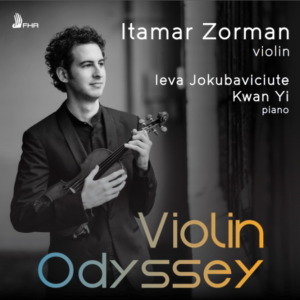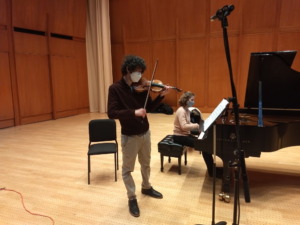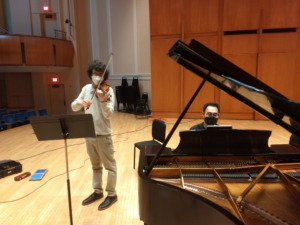
Itamar Zorman Violin Odyssey
Violin Odyssey is the result of my lifelong interest in expanding the violin repertoire, combined with the specific conditions of 2020. Not being able to travel, I started an online series called Hidden Gems, focusing on lesser-known violin repertoire from all over the world. I chose pieces in whose artistic merit I believed strongly and thought that they deserved to be better known. The broadcast combined a live performance of the piece in question, together with a discussion with an expert in that repertoire. I was speaking “on air” with people from around the world, from China to Croatia and Mexico, thus allowing me to keep at least a bit of my usual “globetrotting” self, without boarding on a plane. While the repertoire and the experts were global, my musical collaborators had to be local. Fortunately, I had such wonderful pianists and friends as Ieva Jokubaviciute and Kwan Yi living within driving distance, not to mention my wife, pianist Liza Stepanova, who played with me in the earlier broadcasts. While at first I was streaming from my house in Athens GA, later on the project also helped me become familiar with other musical institutions around where we live, such as the Charlotte Steinway Gallery or the Sigal Music Museum in Greenville SC,
where we recorded some of the later episodes.
After nearly half a year, I had at my fingertips ten pieces, which I thought could be the foundation for an interesting and unusual CD. I particularly enjoyed the number 10 under these particular circumstances, because of the association with Giovanni Boccaccio’s Decameron, where ten people flee the plague to tell ten stories for ten days. The wide geographical origins of the repertoire on the CD (Israel, Croatia, China, Poland, New Zealand, Mexico, USA, Sudan, Czech-Republic and Russia), as well as the noticeable stylistic variety, were the origins of the name “Violin Odyssey” – a far reaching journey of the violin literature.

Itamar Zorman and Ieva Jokubaviciute recording Violin Odyssey
Two larger works set the framework of the CD – Dora Pejačević’s Slavonic Sonata and Erwin Schulhoff’s Second Sonata for Violin and Piano. While sharing some Eastern European flavour, the two Sonatas, written only ten years apart, are stylistically worlds apart. Pejačević’s Sonata (1917) continues and expands on the romantic tradition of violin and piano Sonatas, while Schulhoff’s Sonata (1927) draws from a wide range of sources, from jazz to expressionism. These are two particularly dramatic works, and it made sense to add shorter pieces around them, all of which have evocative titles, perhaps like little adventures and encounters on a traveller’s route.
Grazyna Bacewicz’s Oberek No 1 is an exhilarating fast Polish folk dance to start, but it’s Moshe Zorman’s Wandering that really sets the scene for the journey.
Joseph’s Achron’s Children’s Suite is a collection of miniature “Scenes from childhood”, from a March of Toys to Birdies chirping. Il Afilador and Tierra p’a las macetas by Silvestre Revueltas are encounters with street vendors in Mexico, in which one hears market cries as well as the sharpening wheel. Gao Ping’s Questioning the Mountains ponders over a Szechuan folk song following the tragic circumstances of an earthquake. Ali Osman’s Afromood combines African rhythms with Jazz influences to produce a humor-filled dance. Gareth Farr’s Wakatipu is inspired by an old Maori folk tale about Lake Wakatipu rising and receding. William Grant Still’s Summerland is a vision of beauty in the afterlife.

Itamar Zorman and Kwan Yi recording Violin Odyssey
I am so thankful to the Borletti-Buitoni Trust for their support and guidance, without which this album would not have been made. I am also grateful to David Murphy and First Hand Records for taking on this project and helping with the final repertoire selection and concept of the album, as well as to producer Judith Sherman, who guided us through this vast amount of repertoire with assurance, patience and plenty of good suggestions. I would especially like to thank the two pianists on the album, Ieva Jokubaviciute, who also managed the logistics for using Baldwin Auditorium at Duke University as the recording venue, and Kwan Yi (and special guest, percussionist Julia Thompson), for embarking on this unusual journey with me.
